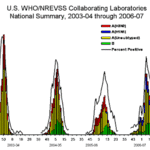Microbiology

Scientists have long known that emotions and other personality traits and disorders run together in families but finding which genes are most important in controlling emotions has proven difficult. Humans and mice have similar numbers of genes, but mice are valuable because their genes can be deleted or added. Many researchers have begun to study mouse behaviors to try to link genes with complex behaviors.
A new report by Wang et al., found that male mice make high-frequency vocalizations during sexual interactions with female mice. These high-frequency calls are associated with approach…

In the Northern hemisphere, winter is the time for the flu. Every year 5% to 20% of us catch "the bug". So predictable is the influenza virus that "flu season" has entered the vernacular. This year, flu cases peaked around the end of February (see chart). Perhaps you've wondered "Why?".
Hypotheses for flu season are numerous and include:
Because people are indoors more often during the winter, they are in close contact more often, and this promotes transmission from person to person.
Cold temperatures lead to drier air, which may dehydrate mucus, preventing the body from effectively…

AIDS may partly be the consequence of an evolutionary accident, said Professor Frank Kirchhoff from the University of Ulm in Germany. at the Society for General Microbiology’s 162nd meeting being held this week at the Edinburgh International Conference Centre.
“AIDS is a deadly disease in people that is caused by human immunodeficiency virus (HIV). But similar viruses such as simian immunodeficiency virus (SIV), which infects monkeys, usually don’t cause disease in their natural monkey hosts,” says Kirchhoff.
Previous studies have established that one of the key differences between the way…

Gram-negative bacteria, like E. coli and salmonella, destroy pathogenic bacteria by disabling the mechanism that produces their protective coating. Scientists have discovered two key proteins that guide one of the two groups of bacteria to make their hardy outer shells -- their defense against the world.
The team discovered the proteins through an extended process of elimination. The scientists looked at microbes in the guts of carpenter ants. The bacteria, which have lived there for millions of years -- passed on over many generations -- have lost many of the traits necessary for survival…

Sleep apnea is a condition characterized by temporary breathing interruptions during sleep, in which disruptions can occur dozens or even hundreds of times a night. According to the National Institutes of Health, it affects more than twelve million Americans.
Researchers at the University of Pennsylvania School of Medicine have provided a detailed look at the molecular pathways underlying sleep apnea and found that, in an animal model of sleep apnea, poorly folded proteins accumulate in one compartment of a muscle nerve cell, which, under certain conditions, tells a cell to heal itself or…

Fungi don't have sexes, they have mating types, but a new study in PLoS says there are similarities between the parts of DNA that determine the sex of plants and animals and the parts of DNA that determine mating types in certain fungi.
It makes fungi interesting as new model organisms in studies of the evolutionary development of sex chromosomes.
In the plant and animal kingdoms there are individuals of different sexes, that is, bearers of either many tiny sex cells (males) or a few large ones (females). In the third eukaryote kingdom (organisms with DNA gathered in the cell nucleus), the…

Overexpressing a protein involved in the uptake of fat in muscle of mice can improve their tolerance to cold temperatures, researchers find in a new study that showcases the over-looked role muscle may play in the cold response.
When temperatures drop, mammals respond by generating heat (thermogenesis), through mechanisms like shivering and breaking down ‘brown fat’ (high energy fat cells that are especially prominent in newborns and hibernating animals).
Considering that muscle accounts for over one-third of body mass and muscle activity regulates fat metabolism, Dalan Jensen and…

Regeneration, the replacement of damaged or lost body parts, is a shared trait among some animal species – as any youngster who has cut an earthworm in half can attest to. But the repair of damaged tissue and organs in higher animals is also one of the primary goals of current stem cell research.
The common aquarium pet, zebrafish, is an excellent genetic model system, capable of regenerating its spinal cord, retina, heart and fins. A group of researchers writing in Genes & Development focused on fin regeneration, as it entails the coordination of a large number of different cells types…

5 million trillion trillion.
That's a lot of zeroes but it's how many single-celled microbes there are on Earth. And they affect almost every ecological process.
Though microbes are everywhere and essentially rule the planet, scientists have never been able to conduct comprehensive studies of microbes and their interactions with one another in their natural habitats. A new study provides the first inventories of microbial capabilities in nine very different types of ecosystems, ranging from coral reefs to deep mines.
Coral from Kingman atol (Northern Line Islands). Credit: Forest Rohwe,…

Developmental biologists at the University of Wisconsin School of Medicine and Public Health (SMPH) say they have gained new understanding of how digits grow and why each digit is different from the others.
Though the research was done on chick digits, it may have implications for humans born with a genetic condition known as bradydactyly, or stubby fingers and toes.
The UW-Madison team showed that growth begins in a portion of the developing digit they have named the phalanx-forming region (PFR). They illustrated that phalanges, structures that later become finger or toe bones, arise not…